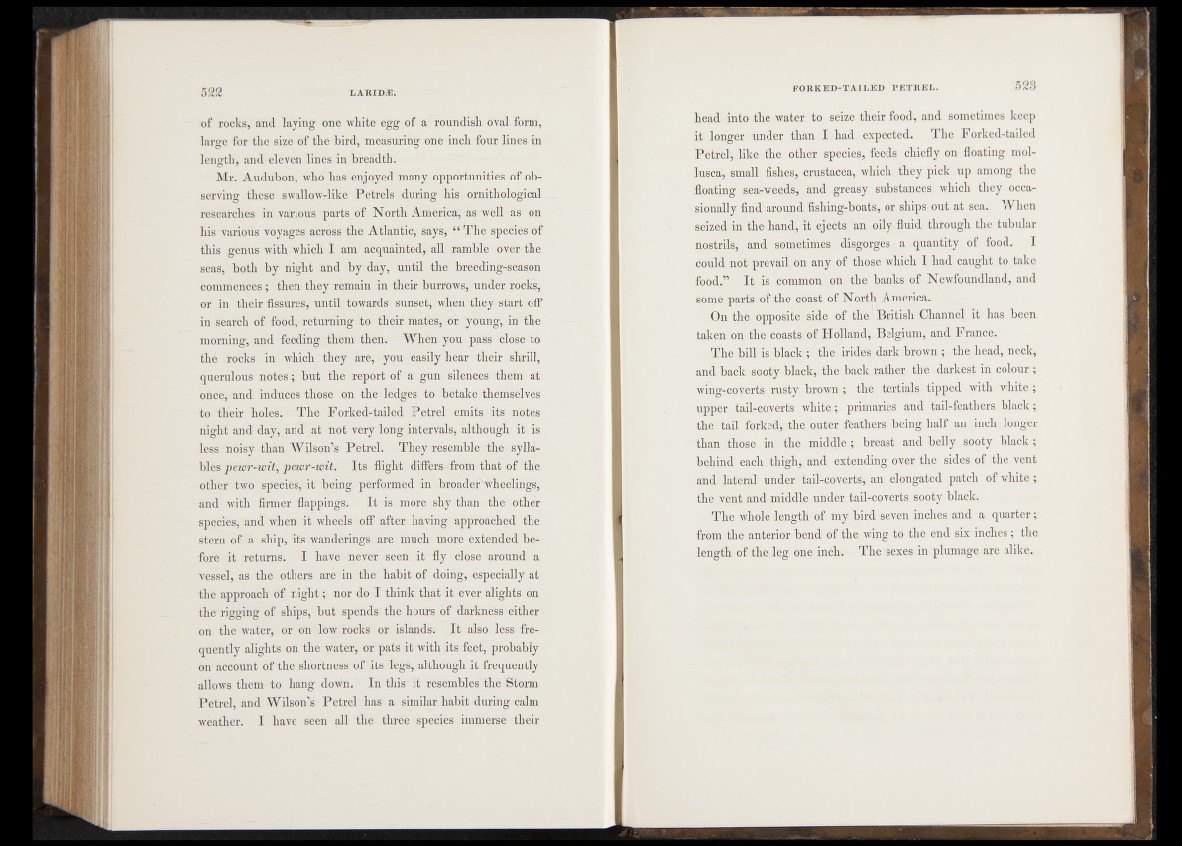
of rocks, and laying one white egg of a roundish oval form,
large for the size of the bird, measuring one inch four lines in
length, and eleven lines in breadth.
Mr. Audubon, who has enjoyed many opportunities öf*lb-
serving these swallowrlike Petrels during ornithological.
researches ini various parts of North America, as well, as on
his various voyages'Across the Atlantic, saysj ** Th«f4j>eïsié& of
this genus with which I am acquainted, all ramble • over'the
seas, both-by night 'and by day, until the breeding-season
commences; then they remain in their burrows, under rocks,
or in their fissures, until towards sunset,‘when they start off
in-search of food, returning to their mates, or youngs ifirtKe
morning, and feeding them then. When you pass
thé rocks in which they'are,-you easily hear1 tK'eir shrill,
querulous notes; but the report of a..gun. silences them at,
once, and induces thösé on the ledges to betake themselves
to their holes. _T h ê “ Forked-tailed Petrel emits' its botes
night and day,.and at not very long-intervals, although- it is
less noisy than Wilson’s Petrel. Theyne'semblef thé^sylla-
bles pewr-wit, pemr-wit. Its flight differs^from * that of'the
other two species, it being performed in broader whëeïihgs,'
and , with firmer flappings. It is more shy than the otln&r
species, and when it wheels off after, having approached, the
stem of a ship, its wanderings are much- more- extended before
it returns. I have neverseemit fly *o$bse around a
Vessel, as the others are in the" "habit of doing,^especially at
the approach óf night; nor do I think that it.ever alights on
the rigging of ships, but spends the hours of darkness either
on the water, or on low rocks or islands. It also1 less frequently
alights on the water, oï pats it with its feet, probably”
on account of the shortness of its legs, although it frequently
allows them to hang down. In this it resembles'the. Storm
Petrel, and Wilson’s Petrel has a similar habit during calm
weather. I havé seen all the three species immerse their
head into the water to seize their food, and sometimes keep
it longer under than - Phad expected. The Forked-tailed
Petrel,,like the^other species^ feeds chiefly on floating mol-
lusca, small fishes, Crustacea, which they pick up among the
floating .s?ea-,we.edl|jhnd greasy substances which they occasionally
find .around fishing^boats, oy, ships out at sea. When
seizdfl-ln the^hand, it e|ÉIfei|'an * oilvkfluid through the tubular
nostrils? and ^® im e s ldisgprges5 a quantity, of food. I
an^^4fe'S%which I,had caught to take
It „is^eommOUvion the^nnlis of'Newfoundland, and
-S;@nfA parts of ,^e^|>as,t, o>§ North Amefica^
I On Channel 1% has been
taken? on thq cqasfp of Holland, Belgium, and France.
The- billf^]blajcbj^aTic3i©§‘- browft?| the head, neck,
qf f l Hj j f e f t gkba c k- r a t he r the darkest in colour;'
wing-!,c0ïVSr%&’us^brown'; thé? ,tmti|f|s \ tipped- with white ;
'upper''<ta>il-,Q©jy erts white’; primax|p| and tail-feathers bjack;
:|ïediail jdfy^ad,' the outén feathers- being half an inch longer
;tj,an^th^e'4^ the brekgfc and belly sooty black;
behir^^if^ithigh, and*. estefiding over the? sideé» f f the vent
an^|l^|erar unde^i|^^dvetts,j an* elongated patch of white ;-
ïhëigent and middle .under fail-cove^ts- sooty black,
^fT-he* Musk*: length of- my^it^JSeven inches- and a quarter;
from, the anterior bend of the, wing to the end six inches; the
length of the leg one inch. The sexes- in plumage-are alike.